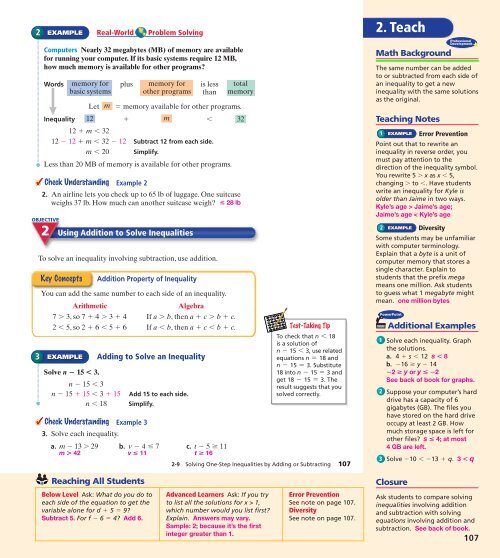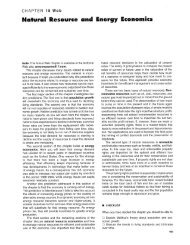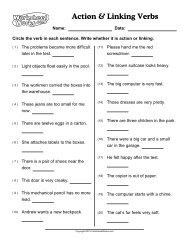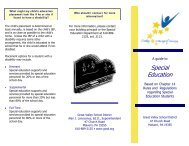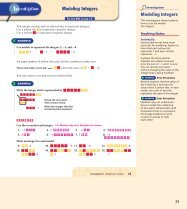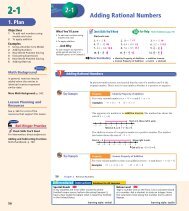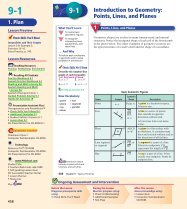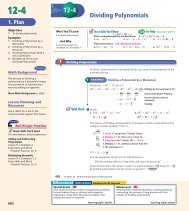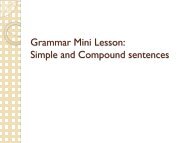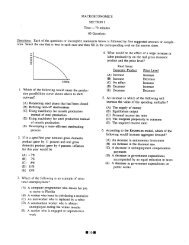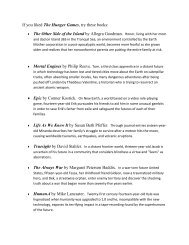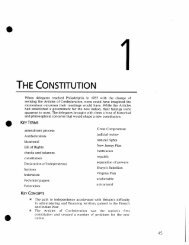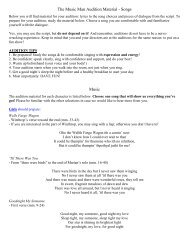Pre Alg TE Lesson 2-9
Pre Alg TE Lesson 2-9
Pre Alg TE Lesson 2-9
Create successful ePaper yourself
Turn your PDF publications into a flip-book with our unique Google optimized e-Paper software.
2<br />
EXAMPLE<br />
Real-World<br />
Problem Solving<br />
2. Teach<br />
Computers Nearly 32 megabytes (MB) of memory are available<br />
for running your computer. If its basic systems require 12 MB,<br />
how much memory is available for other programs?<br />
Words memory for plus memory for is less<br />
basic systems other programs than<br />
Let m = memory available for other programs.<br />
Inequality 12 + m<br />
, 32<br />
12 + m , 32<br />
12 - 12 + m , 32 - 12 Subtract 12 from each side.<br />
m , 20 Simplify.<br />
Less than 20 MB of memory is available for other programs.<br />
Check Understanding Example 2<br />
2. An airline lets you check up to 65 lb of luggage. One suitcase<br />
weighs 37 lb. How much can another suitcase weigh? K 28 lb<br />
OBJECTIVE<br />
3<br />
2<br />
Using Addition to Solve Inequalities<br />
To solve an inequality involving subtraction, use addition.<br />
Key Concepts<br />
Addition Property of Inequality<br />
You can add the same number to each side of an inequality.<br />
Arithmetic<br />
7 . 3, so 7 + 4 . 3 + 4<br />
2 , 5, so 2 + 6 , 5 + 6<br />
EXAMPLE<br />
Solve n – 15 R 3.<br />
n - 15 , 3<br />
n - 15 + 15 , 3 + 15<br />
n , 18<br />
Check Understanding Example 3<br />
3. Solve each inequality.<br />
<strong>Alg</strong>ebra<br />
If a . b, then a + c . b + c.<br />
If a , b, then a + c , b + c.<br />
Adding to Solve an Inequality<br />
Add 15 to each side.<br />
Simplify.<br />
a. m - 13 . 29 b. v - 4 # 7 c. t - 5 $ 11<br />
m S 42 v K 11 t L 16<br />
total<br />
memory<br />
1 A B C D E<br />
2 A B C D E<br />
3 A B C D E<br />
4 A B C D E<br />
5 A B C D E<br />
B C D E<br />
Test-Taking Tip<br />
To check that n , 18<br />
is a solution of<br />
n - 15 , 3, use related<br />
equations n = 18 and<br />
n - 15 = 3. Substitute<br />
18 into n - 15 = 3 and<br />
get 18 - 15 = 3. The<br />
result suggests that you<br />
solved correctly.<br />
2-9 Solving One-Step Inequalities by Adding or Subtracting 107<br />
Math Background<br />
The same number can be added<br />
to or subtracted from each side of<br />
an inequality to get a new<br />
inequality with the same solutions<br />
as the original.<br />
Teaching Notes<br />
1<br />
Error <strong>Pre</strong>vention<br />
Point out that to rewrite an<br />
inequality in reverse order, you<br />
must pay attention to the<br />
direction of the inequality symbol.<br />
You rewrite 5 . x as x , 5,<br />
changing . to ,. Have students<br />
write an inequality for Kyle is<br />
older than Jaime in two ways.<br />
Kyle’s age > Jaime’s age;<br />
Jaime’s age < Kyle’s age<br />
2<br />
Diversity<br />
Some students may be unfamiliar<br />
with computer terminology.<br />
Explain that a byte is a unit of<br />
computer memory that stores a<br />
single character. Explain to<br />
students that the prefix mega<br />
means one million. Ask students<br />
to guess what 1 megabyte might<br />
mean. one million bytes<br />
1<br />
2<br />
3<br />
EXAMPLE<br />
EXAMPLE<br />
PowerPoint<br />
Additional Examples<br />
Solve each inequality. Graph<br />
the solutions.<br />
a. 4 + s , 12 s R 8<br />
b. -16 $ y - 14<br />
–2 L y or y K–2<br />
See back of book for graphs.<br />
Suppose your computer’s hard<br />
drive has a capacity of 6<br />
gigabytes (GB). The files you<br />
have stored on the hard drive<br />
occupy at least 2 GB. How<br />
much storage space is left for<br />
other files? s K 4; at most<br />
4 GB are left.<br />
Solve -10 , -13 + q. 3 R q<br />
Reaching All Students<br />
Closure<br />
Below Level Ask: What do you do to<br />
each side of the equation to get the<br />
variable alone for d + 5 = 9?<br />
Subtract 5. For f - 6 = 4? Add 6.<br />
Advanced Learners Ask: If you try<br />
to list all the solutions for x > 1,<br />
which number would you list first?<br />
Explain. Answers may vary.<br />
Sample: 2; because it’s the first<br />
integer greater than 1.<br />
Error <strong>Pre</strong>vention<br />
See note on page 107.<br />
Diversity<br />
See note on page 107.<br />
Ask students to compare solving<br />
inequalities involving addition<br />
and subtraction with solving<br />
equations involving addition and<br />
subtraction. See back of book.<br />
107


